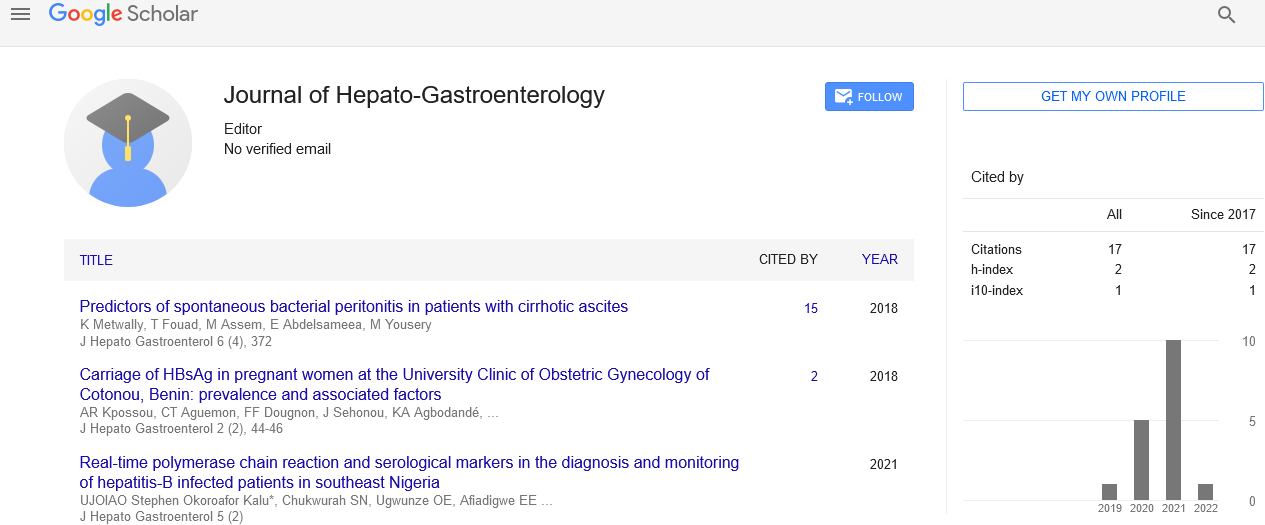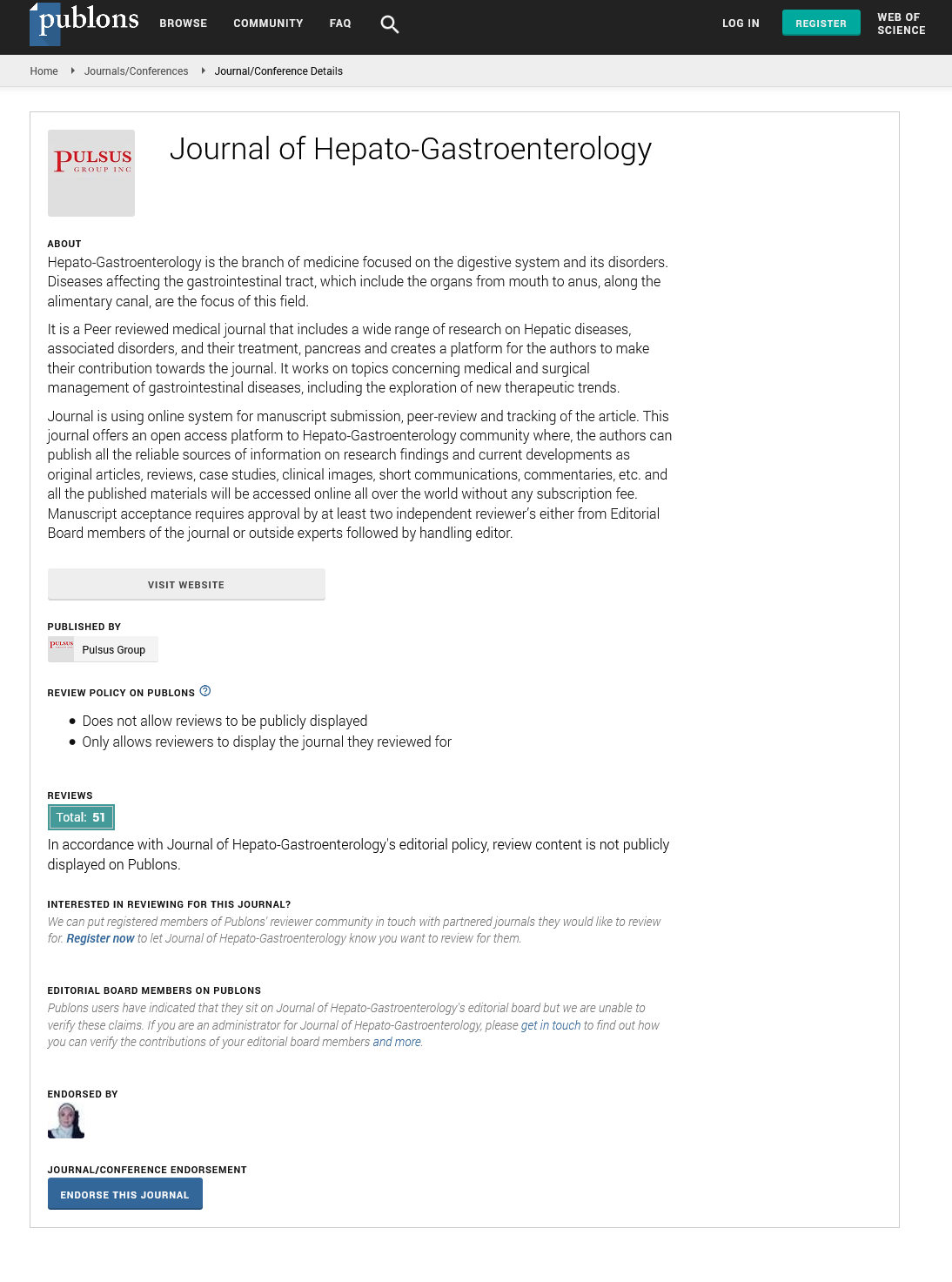Advances And Difficulties In Cirrhosis And Portal Hypertension
Received: 09-Mar-2022, Manuscript No. PULHG-22-4442; Editor assigned: 15-Mar-2022, Pre QC No. PULHG-22-4442 (PQ); Reviewed: 19-Mar-2022 QC No. PULHG-22-4442; Revised: 23-Mar-2022, Manuscript No. PULHG-22-4442 (R); Published: 13-Apr-2022, DOI: 10.37532/pulhg.22.6.2.1-2
This open-access article is distributed under the terms of the Creative Commons Attribution Non-Commercial License (CC BY-NC) (http://creativecommons.org/licenses/by-nc/4.0/), which permits reuse, distribution and reproduction of the article, provided that the original work is properly cited and the reuse is restricted to noncommercial purposes. For commercial reuse, contact reprints@pulsus.com
Abstract
Liver cirrhosis is the fourth reason for death in grown-ups in Western nations, with complexities of entrance hypertension being answerable for most losses. To diminish mortality, advancement of exact analytic strategies for early finding, successful etiologic treatment, worked on pharmacological treatment for entrance hypertension, and powerful treatments for end-stage liver disappointment are required. Early discovery of cirrhosis and gateway hypertension is currently conceivable utilizing straightforward harmless techniques, prompting the headway of individualized risk delineation in clinical practice. Notwithstanding past presumptions, cirrhosis can relapse assuming its etiologic reason is actually eliminated. By and by, while this is currently feasible for cirrhosis brought about by ongoing hepatitis C, the frequency of cirrhosis because of non-alcoholic steatohepatitis has expanded drastically and compelling treatments are not yet accessible. New medications following up on the unique part of hepatic vascular obstruction are being considered and will probably work on the future administration of entrance hypertension. Cirrhosis is currently considered to be a unique sickness ready to advance and relapse between the redressed and decompensated stages. This assessment article intends to give the writer's very own perspective on the current significant advances and difficulties in this field.
Key Words
Liver cirrhosis; Reflux
Introduction
Chronic Liver Illness (CLD) influences in excess of 29 million individuals in Europe and north of 300 million individuals around the world. The fundamental driver of CLD is liquor misuse, persistent viral hepatitis, and metabolic variables (non-alcoholic greasy liver sickness). Over the long run, extracellular fibrotic tissue creates and aggregates in the liver because of persistent injury, continuously prompting sinewy septa that forestall typical oxygenation and blood trade to the liver parenchyma. This latestage, highlighting stamped liver physical changes, including hepatocyte termination, miniature, and macrovascular redesigning, neoangiogenesis, knob arrangement, and improvement of portosystemic shunts, is named 'cirrhosis'. Mortality in CLD is basically because of confusions of liver cirrhosis and Hepatocellular Carcinoma (HCC), which is impressively more pervasive in patients with cirrhosis. The term 'progressed ongoing liver sickness' Anterior Cruciate Ligament Deficient (ACLD) has been as of late proposed to all the more likely mirror the late phases of CLD, which ought to be considered inside a continuum range, going from serious fibrosis to completely created cirrhosis.
Background
As per the biggest review accessible hitherto, cirrhosis addresses the fourth reason for death because of non-transferable illnesses around the world, with the absolute number of passing’s from cirrhosis and liver disease having consistently ascended by roughly 50 million every year in the course of the most recent twenty years. This huge death rate is expected, somewhat, to a late analysis. A decades-in length asymptomatic stage during which no unmistakable indication of the infection is seen is normal for CLD. Without a doubt, even after the beginning of cirrhosis, the infection can stay asymptomatic, or 'redressed', for quite a while. During this time, entryway hypertension logically grows, normally joined by a decrease in hepatocellular work. Entry hypertension is the significant driver in the change from the repaid to the 'decompensated' phase of cirrhosis, characterized by the presence of clinical intricacies, including ascites, draining from gastroesophageal varices, unconstrained bacterial peritonitis, hepatorenal disorder, and hepatic encephalopathy. Further decompensating episodes are frequently set off by bacterial contaminations and are related to extremely high mortality risk. According to a prognostic perspective, redressed and decompensated cirrhosis are significantly unique and can be considered as two separate infections. Moreover, inside these two significant stages, a few sub-stages with the differing chance of additional decompensation and passing can be recognized. Information on the pathophysiological instruments driving the progress inside these stages is key in the current administration of cirrhosis. Other than its adverse consequence on future, cirrhosis suggests a few different weights, remembering an undeniable increment for medical care costs because of hospitalization and therapy (assessed at around $2.5 billion every year in the US), loss of usefulness (assessed at $10.6 billion every year in the US), and an obvious decrease in personal satisfaction. These weights are solely brought about by inconveniences during the decompensated stage.
Conclusion
Right now, cirrhosis is viewed as a powerful sickness ready to advance and relapse. In this better approach for understanding the range of changes describing ACLD, early determination, before the event of decompensation, is a significant stage to accomplish a decrease in mortality because of CLD since a few different pharmacological and non-pharmacological methodologies can be utilized during this stage to forestall decompensation (an inauspicious advance in the normal history of this sickness). Ultrasound electrography of the liver permits an exact painless recognizable proof of patients with ACLD, with the extra benefit of giving a mathematical proxy of the gamble of entrance hypertension and difficulties. Anticipation of decompensation is conceivable by lessening entryway tension through measures pointed toward wiping out every one of the potential wellsprings of injury (etiology and cofactors), at diminishing intrahepatic opposition (e.g., by rectifying intrahepatic endothelial brokenness), and at decreasing portocollateral stream. Long-standing medications, stay the backbone for entry pressure decrease and can forestall variceal dying, yet in addition other more regular decompensating occasions like ascites. After decompensation, treatment ought to be pointed towards keeping away from additional decompensation and demise, with statins being promising in these cases. Transjugular Intrahepatic Portosystemic Shunt (TIPS) is viable in diminishing the gamble of variceal rebleeding and further develops mortality in patients with intermittent and headstrong ascites. The degree to which balancing the stomach microbiota impacts the regular history of decompensated cirrhosis stays obscure, yet antimicrobials as of now assume a significant part in the counteraction and treatment of serious bacterial disease in decompensated patients. Sadly, in spite of the undeniable improvement in the administration of entrance hypertension, serious liver disappointment can't be turned around. Powerful fake liver help stays a significant neglected need in patients with end-stage liver sickness, with liver transplantation addressing the main accessible healing choice to date (in the people who have no contraindications). For sure, research in the field of regenerative medication addresses a significant expected leap forward of the 21st century, holding an extraordinary guarantee for a decrease in the need for liver transplantation later on






